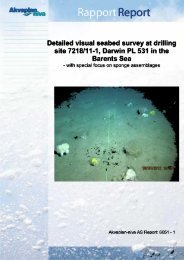A study of the priority substances of the Water Framework Directive ...
A study of the priority substances of the Water Framework Directive ...
A study of the priority substances of the Water Framework Directive ...
Create successful ePaper yourself
Turn your PDF publications into a flip-book with our unique Google optimized e-Paper software.
..:::::::::: zinc<br />
..:::82<br />
b Zinc<br />
� Zinc is a metal with acute and chronic toxicity<br />
for aquatic organisms.<br />
� No fur<strong>the</strong>r screening is necessary.<br />
Production and use<br />
Zinc compounds are used as active <strong>substances</strong><br />
in biocidal products, as surface protector for<br />
o<strong>the</strong>r metals and as a stabilizer in plastic.<br />
Metallic zinc is used in electric appliances,<br />
coins, building materials, sinks, buckets, ro<strong>of</strong>ing<br />
etc.<br />
Emissions, discharges,<br />
distribution and hot-spots<br />
Main emissions <strong>of</strong> zinc comes from industry,<br />
mining, waste incineration and products.<br />
Monitoring<br />
Monitoring <strong>of</strong> zinc has been part <strong>of</strong> JAMP and<br />
RID and time trends exist here. Zinc has also<br />
been investigated in o<strong>the</strong>r studies (see references).<br />
Marine sediment<br />
High zinc levels in sediments are found in connection<br />
with mining or shipyards.<br />
Marine biota<br />
Shellfish in harbours in Nordland has been<br />
screened. Narvik and Svolvær are highly polluted.<br />
Fresh water<br />
10 rives have been monitored, but concentrations<br />
are generally low; <strong>the</strong> samples with highest<br />
concentrations have been Class III.<br />
Fresh water sediment<br />
Lakes affected by mining, are polluted. In o<strong>the</strong>r<br />
lakes concentrations are low.<br />
Fresh water biota<br />
Insect larvae, especially mayfly, living downstream<br />
mines are shown to have increased body<br />
zink concentration.<br />
Hotspots<br />
Lakes, rivers and streams affected by mining are<br />
hotspots for zinc pollution. These are being<br />
monitored today.<br />
A <strong>study</strong> <strong>of</strong> <strong>the</strong> <strong>priority</strong> <strong>substances</strong> <strong>of</strong> <strong>the</strong> <strong>Water</strong> <strong>Framework</strong> <strong>Directive</strong><br />
TA-2140/2005<br />
FACTS<br />
Zinc is a metal which is essential to all organisms, but<br />
high concentrations have adverse effects, especially<br />
in aquatic organisms. Zinc also has chronic toxicity<br />
for aquatic organisms. There is some bioaccumulation,<br />
but negligible biomagnification. Very high levels<br />
are required to cause adverse health effects, but as<br />
zinc is associated with cadmium, high zinc levels may<br />
indicate o<strong>the</strong>r effects.<br />
Need for fur<strong>the</strong>r screening and monitoring<br />
Zinc is thoroughly screened. No fur<strong>the</strong>r screening<br />
is necessary.<br />
Analysis<br />
There are several well-established techniques for<br />
determination <strong>of</strong> Zn. Several companies <strong>of</strong>fer<br />
this service in Norway and Europe. The most<br />
frequently techniques are Inductively coupled<br />
plasma mass spectrometry (ICP-MS), Inductively<br />
coupled Plasma Atomic Emission Spectroscopy<br />
(ICP-AES), Graphite Furnace Atomic<br />
Absorption Spectroscopy (GF-AAS) and Flame<br />
Atomic Absorption Spectroscopy (F-AAS).<br />
Methods<br />
<strong>Water</strong> samples are acidified with 1-10% nitric<br />
acid.<br />
For analysis <strong>of</strong> solid samples, <strong>the</strong> methods are<br />
based on digestion with nitric acid / hydrogen<br />
peroxide in sealed containers using microwave<br />
system.<br />
Synergy with o<strong>the</strong>r analyses<br />
The sample digestion method used for determination<br />
<strong>of</strong> zinc can also be used for determination<br />
<strong>of</strong> Pb, Hg, Ni, Cu, Cr, As and Ni.<br />
References<br />
� Heavy metals and persistent organic pollutants<br />
in sediments and fish from lakes in<br />
Nor<strong>the</strong>rn and Arctic regions <strong>of</strong> Norway, rapportnr.<br />
688/97<br />
� Miljøgifter i fisk, skalldyr og sediment i havneområder<br />
og fjorder i Rogaland 1999-2000.<br />
TA-1843/2001.<br />
� Miljøgifter i havneområder i Nordland, TA-<br />
1967-2003

















